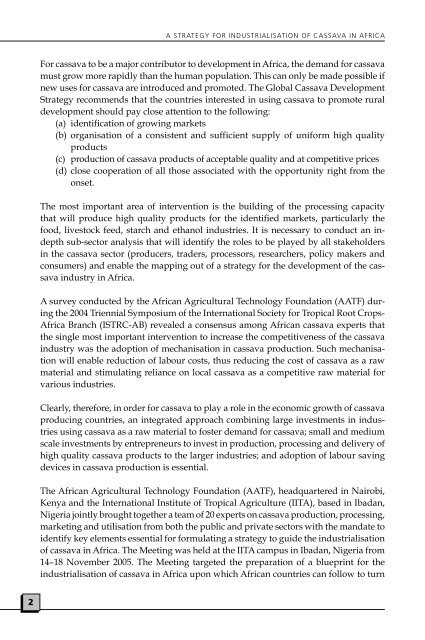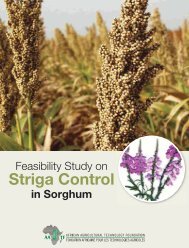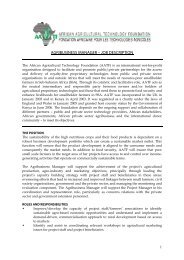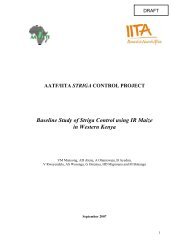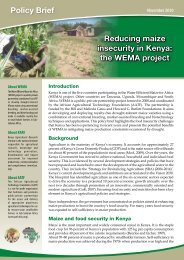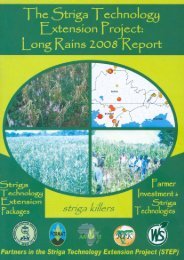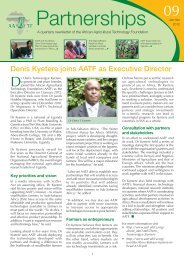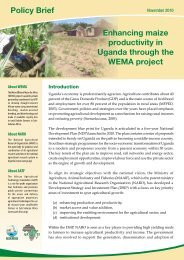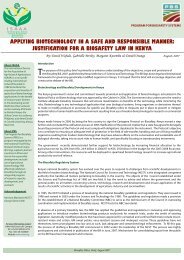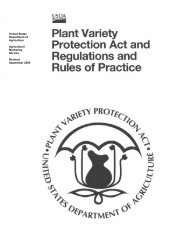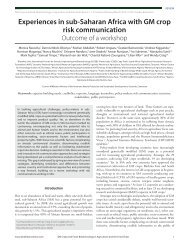A strategy for industrialisation of cassava in Africa - African ...
A strategy for industrialisation of cassava in Africa - African ...
A strategy for industrialisation of cassava in Africa - African ...
You also want an ePaper? Increase the reach of your titles
YUMPU automatically turns print PDFs into web optimized ePapers that Google loves.
A STRATEGY FOR INDUSTRIALISATION OF CASSAVA IN AFRICA<br />
For <strong>cassava</strong> to be a major contributor to development <strong>in</strong> <strong>Africa</strong>, the demand <strong>for</strong> <strong>cassava</strong><br />
must grow more rapidly than the human population. This can only be made possible if<br />
new uses <strong>for</strong> <strong>cassava</strong> are <strong>in</strong>troduced and promoted. The Global Cassava Development<br />
Strategy recommends that the countries <strong>in</strong>terested <strong>in</strong> us<strong>in</strong>g <strong>cassava</strong> to promote rural<br />
development should pay close attention to the follow<strong>in</strong>g:<br />
(a) identification <strong>of</strong> grow<strong>in</strong>g markets<br />
(b) organisation <strong>of</strong> a consistent and sufficient supply <strong>of</strong> uni<strong>for</strong>m high quality<br />
products<br />
(c) production <strong>of</strong> <strong>cassava</strong> products <strong>of</strong> acceptable quality and at competitive prices<br />
(d) close cooperation <strong>of</strong> all those associated with the opportunity right from the<br />
onset.<br />
The most important area <strong>of</strong> <strong>in</strong>tervention is the build<strong>in</strong>g <strong>of</strong> the process<strong>in</strong>g capacity<br />
that will produce high quality products <strong>for</strong> the identified markets, particularly the<br />
food, livestock feed, starch and ethanol <strong>in</strong>dustries. It is necessary to conduct an <strong>in</strong>depth<br />
sub-sector analysis that will identify the roles to be played by all stakeholders<br />
<strong>in</strong> the <strong>cassava</strong> sector (producers, traders, processors, researchers, policy makers and<br />
consumers) and enable the mapp<strong>in</strong>g out <strong>of</strong> a <strong>strategy</strong> <strong>for</strong> the development <strong>of</strong> the <strong>cassava</strong><br />
<strong>in</strong>dustry <strong>in</strong> <strong>Africa</strong>.<br />
A survey conducted by the <strong>Africa</strong>n Agricultural Technology Foundation (AATF) dur<strong>in</strong>g<br />
the 2004 Triennial Symposium <strong>of</strong> the International Society <strong>for</strong> Tropical Root Crops-<br />
<strong>Africa</strong> Branch (ISTRC-AB) revealed a consensus among <strong>Africa</strong>n <strong>cassava</strong> experts that<br />
the s<strong>in</strong>gle most important <strong>in</strong>tervention to <strong>in</strong>crease the competitiveness <strong>of</strong> the <strong>cassava</strong><br />
<strong>in</strong>dustry was the adoption <strong>of</strong> mechanisation <strong>in</strong> <strong>cassava</strong> production. Such mechanisation<br />
will enable reduction <strong>of</strong> labour costs, thus reduc<strong>in</strong>g the cost <strong>of</strong> <strong>cassava</strong> as a raw<br />
material and stimulat<strong>in</strong>g reliance on local <strong>cassava</strong> as a competitive raw material <strong>for</strong><br />
various <strong>in</strong>dustries.<br />
Clearly, there<strong>for</strong>e, <strong>in</strong> order <strong>for</strong> <strong>cassava</strong> to play a role <strong>in</strong> the economic growth <strong>of</strong> <strong>cassava</strong><br />
produc<strong>in</strong>g countries, an <strong>in</strong>tegrated approach comb<strong>in</strong><strong>in</strong>g large <strong>in</strong>vestments <strong>in</strong> <strong>in</strong>dustries<br />
us<strong>in</strong>g <strong>cassava</strong> as a raw material to foster demand <strong>for</strong> <strong>cassava</strong>; small and medium<br />
scale <strong>in</strong>vestments by entrepreneurs to <strong>in</strong>vest <strong>in</strong> production, process<strong>in</strong>g and delivery <strong>of</strong><br />
high quality <strong>cassava</strong> products to the larger <strong>in</strong>dustries; and adoption <strong>of</strong> labour sav<strong>in</strong>g<br />
devices <strong>in</strong> <strong>cassava</strong> production is essential.<br />
The <strong>Africa</strong>n Agricultural Technology Foundation (AATF), headquartered <strong>in</strong> Nairobi,<br />
Kenya and the International Institute <strong>of</strong> Tropical Agriculture (IITA), based <strong>in</strong> Ibadan,<br />
Nigeria jo<strong>in</strong>tly brought together a team <strong>of</strong> 20 experts on <strong>cassava</strong> production, process<strong>in</strong>g,<br />
market<strong>in</strong>g and utilisation from both the public and private sectors with the mandate to<br />
identify key elements essential <strong>for</strong> <strong>for</strong>mulat<strong>in</strong>g a <strong>strategy</strong> to guide the <strong><strong>in</strong>dustrialisation</strong><br />
<strong>of</strong> <strong>cassava</strong> <strong>in</strong> <strong>Africa</strong>. The Meet<strong>in</strong>g was held at the IITA campus <strong>in</strong> Ibadan, Nigeria from<br />
14–18 November 2005. The Meet<strong>in</strong>g targeted the preparation <strong>of</strong> a bluepr<strong>in</strong>t <strong>for</strong> the<br />
<strong><strong>in</strong>dustrialisation</strong> <strong>of</strong> <strong>cassava</strong> <strong>in</strong> <strong>Africa</strong> upon which <strong>Africa</strong>n countries can follow to turn<br />
2


